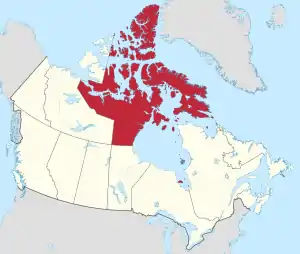List of municipalities in Nunavut
Nunavut is the second-least populous of Canada's three territories with 35,944 residents as of 2016, but the largest territory in land area[lower-alpha 1] at 1,877,779 km2 (725,015 sq mi).[1] Nunavut's 25 municipalities cover only 0.2% of the territory's land mass[lower-alpha 2] but are home to 99.83% of its population.[lower-alpha 3][1][3][4]
Municipalities are created by the Government of Nunavut in accordance with the 2003 Cities, Towns and Villages Act (CTVA) and the 2003 Hamlets Act,[5][6] which are statutes of the neighbouring Northwest Territories.[lower-alpha 4] According to the CTVA, a municipality is an "area within the boundaries of a municipal corporation, as described in the order establishing or continuing the municipal corporation" where a municipal corporation is either a city, town or village.[5] According to the Hamlets Act, a municipality is similarly an "area within the boundaries of a hamlet, as described in the order establishing or continuing the hamlet". All of Nunavut's 25 municipalities are hamlets except for the City of Iqaluit,[4] which is the territory's capital.
The largest municipality by population in Nunavut is Iqaluit with 7,740 residents, home to 21.5% of the territory's population.[3] The smallest municipality by population is Grise Fiord with 129 residents.[3] The largest municipality by land area is Kugluktuk, which spans 549.65 km2 (212.22 sq mi), while the smallest is Kimmirut at 2.27 km2 (0.88 sq mi).[3]
Cities
An application can be submitted to incorporate a community as a city under the CTVA of the Northwest Territories[lower-alpha 4] at the request of a minimum 25 residents that are eligible electors, or at the initiative of the Minister of Municipal and Community Affairs.[5] The proposed city must have a minimum assessed land value of $200 million or an exception made by the Minister.[5] Iqaluit is the only city in Nunavut, with 7,740 residents and a land area of 52.50 km2 (20.27 sq mi) in 2011.[3] It incorporated as a city on April 19, 2001.[11]
Towns
Although Nunavut has no municipalities with town status, the CTVA provides opportunity to incorporate a town. A town can be incorporated at the request of a minimum 25 residents that are eligible electors, or at the initiative of the Minister of Municipal and Community Affairs.[5] The proposed town must have a minimum assessed land value of $50 million or an exception made by the Minister.[5] Iqaluit held town status between 1980 and 2001.[12]
Villages
Nunavut has no villages, but like town status the CTVA provides opportunity to incorporate a village. A village can be incorporated at the request of a minimum 25 residents that are eligible electors, or at the initiative of the Minister of Municipal and Community Affairs.[5] The proposed village must have a minimum assessed land value of $10 million or an exception made by the Minister.[5] Iqaluit held village status between 1974 and 1980.[12]
Hamlets
At the request of a minimum 25 residents that are eligible electors, or at the initiative of the Minister of Municipal and Community Affairs, an application can be submitted to incorporate a community as a hamlet under the Hamlets Act of the Northwest Territories.[lower-alpha 4][6] Unlike cities, towns and villages, the incorporation of hamlets is not conditioned by a prescribed minimum assessed land value.[6]
Nunavut has 24 hamlets. The largest hamlet by population is Rankin Inlet, with 2,842 residents, and the smallest is Grise Fiord, with 129 residents.[3] The largest hamlet by land area is Kugluktuk, which spans 549.65 km2 (212.22 sq mi), while the smallest is Kimmirut, at 2.27 km2 (0.88 sq mi).[3]
List of municipalities
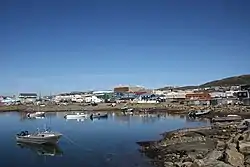
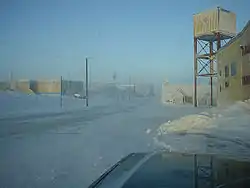
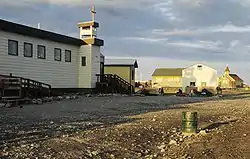
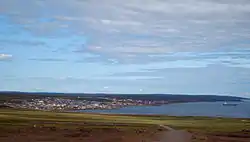
| Name | Status[4] | 2016 Census of Population[3] | ||||
|---|---|---|---|---|---|---|
| Population (2016) | Population (2011) | Change | Land area (km²) | Population density | ||
| Arctic Bay | Hamlet | 868 | 823 | +5.5% | 247.50 | 3.5/km2 |
| Arviat | Hamlet | 2,657 | 2,318 | +14.6% | 132.07 | 20.1/km2 |
| Baker Lake | Hamlet | 2,069 | 1,872 | +10.5% | 182.22 | 11.4/km2 |
| Cambridge Bay | Hamlet | 1,766 | 1,608 | +9.8% | 202.35 | 8.7/km2 |
| Cape Dorset | Hamlet | 1,441 | 1,363 | +5.7% | 9.74 | 147.9/km2 |
| Chesterfield Inlet | Hamlet | 437 | 313 | +39.6% | 141.10 | 3.1/km2 |
| Clyde River | Hamlet | 1,053 | 934 | +12.7% | 106.55 | 9.9/km2 |
| Coral Harbour | Hamlet | 891 | 834 | +6.8% | 137.91 | 6.5/km2 |
| Gjoa Haven | Hamlet | 1,324 | 1,279 | +3.5% | 28.47 | 46.5/km2 |
| Grise Fiord | Hamlet | 129 | 130 | −0.8% | 332.70 | 0.4/km2 |
| Hall Beach | Hamlet | 848 | 736 | +15.2% | 16.82 | 50.4/km2 |
| Igloolik | Hamlet | 1,744[13] | 1,454 | +19.9% | 103.01 | 16.9/km2 |
| Iqaluit | City | 7,740 | 6,699 | +15.5% | 52.50 | 147.4/km2 |
| Kimmirut | Hamlet | 389 | 455 | −14.5% | 2.27 | 171.4/km2 |
| Kugaaruk | Hamlet | 933 | 771 | +21.0% | 4.97 | 187.7/km2 |
| Kugluktuk | Hamlet | 1,491 | 1,450 | +2.8% | 549.65 | 2.7/km2 |
| Naujaat[lower-alpha 5] | Hamlet | 1,082 | 945 | +14.5% | 424.27 | 2.6/km2 |
| Pangnirtung | Hamlet | 1,481 | 1,425 | +3.9% | 7.77 | 190.6/km2 |
| Pond Inlet | Hamlet | 1,617 | 1,549 | +4.4% | 173.36 | 9.3/km2 |
| Qikiqtarjuaq | Hamlet | 598 | 520 | +15.0% | 130.71 | 4.6/km2 |
| Rankin Inlet | Hamlet | 2,842 | 2,577 | +10.3% | 20.24 | 140.4/km2 |
| Resolute | Hamlet | 198 | 214 | −7.5% | 116.89 | 1.7/km2 |
| Sanikiluaq | Hamlet | 882 | 812 | +8.6% | 114.94 | 7.7/km2 |
| Taloyoak | Hamlet | 1,029 | 899 | +14.5% | 37.65 | 27.3/km2 |
| Whale Cove | Hamlet | 435 | 407 | +6.9% | 283.66 | 1.5/km2 |
| Total municipalities | — | 35,944 | 32,387 | +11.0% | 3,559.32 | 10.1/km2 |
| Territory of Nunavut | — | 35,944 | 32,397[lower-alpha 6] | +10.9% | 1,877,778.53 | 0.02/km2 |
Notes
- Nunavut also has a larger land area than any of Canada's ten provinces.[1]
- The remaining 99.8% of Nunavut's land mass comprises three small unincorporated settlements (0.015%) and three vast unorganized areas (99.796%).[2][3]
- The remaining 0.19%, or 62 residents live in the unincorporated Unorganized Baffin.[3]
- Nunavut was created from a portion of the Northwest Territories (NWT) on April 1, 1999. The Nunavut Act of 1993, which created the territory, provided for statutes and regulations of the NWT that were in force on March 31, 1999 to also be in force for Nunavut,[7][8] including the 1988 Cities, Towns and Villages Act and the 1988 Hamlets Act.[9] The Government of Nunavut subsequently amended these acts in 2003.[10]
- Repulse Bay was officially renamed Naujaat on July 2, 2015.[14]
- Statistics Canada published the 2011 population of Nunavut as 31,906.[1] It subsequently published amended population counts for three of Nunavut's census subdivisions. The population of 32,397 reflects the amended population counts for Hall Beach (amended from 546 to 736), Nanisivik (amended from 10 to 0) and Rankin Inlet (amended from 2,266 to 2,577).[15]
References
- "Population and dwelling counts, for Canada, provinces and territories, 2016 and 2011 censuses – 100% data". Statistics Canada. February 6, 2017. Retrieved February 11, 2017.
- "Interim List of Changes to Municipal Boundaries, Status, and Names: From January 2, 2012 to January 1, 2013" (PDF) (PDF). Statistics Canada. pp. 6–7. Retrieved August 19, 2014.
- "Population and dwelling counts, for Canada, provinces and territories, and census subdivisions (municipalities), 2016 and 2011 censuses – 100% data (Nunavut)". Statistics Canada. February 8, 2017. Retrieved February 11, 2017.
- "List of municipalities – Nunavut". Canada Revenue Agency. September 6, 2013. Retrieved January 15, 2014.
- "Cities, Towns and Villages Act, S.N.W.T. 2003, c.22" (PDF) (PDF). Government of the Northwest Territories. October 1, 2013. pp. 2–3 and 6. Archived from the original (PDF) on January 12, 2014. Retrieved January 12, 2014.
- "Hamlets Act, S.N.W.T. 2003, c.22" (PDF) (PDF). Government of the Northwest Territories. October 1, 2013. pp. 16 and 18–19. Archived from the original (PDF) on January 12, 2014. Retrieved January 12, 2014.
- "Nunavut Legislation". Law Library at the Nunavut Court of Justice. Retrieved October 17, 2014.
- "Welcome to the web page for the Legislation Division of the Justice Department of the Government of Nunavut". Government of Nunavut Department of Justice. Archived from the original on October 18, 2014. Retrieved October 19, 2014.
- "Consolidated Statutes and Regulations current to April 1, 1999". Government of Nunavut Department of Justice. Archived from the original on October 19, 2014. Retrieved October 19, 2014.
- "Assessment of the Municipal Acts of the Provinces and Territories" (PDF) (PDF). Federation of Canadian Municipalities. April 2004. p. 6. Retrieved January 15, 2014.
- "Interim List of Changes to Municipal Boundaries, Status, and Names From January 2, 2001 to January 1, 2006" (PDF) (PDF). Statistics Canada. June 2007. p. 372. Retrieved December 12, 2014.
- "About Iqaluit: History". City of Iqaluit. Archived from the original on December 11, 2014. Retrieved December 12, 2014.
- "Population and dwelling count amendments, 2016 Census". Statistics Canada. January 16, 2018. Retrieved February 3, 2018.
- "Naujaat, Nunavut, residents celebrate official renaming: Repulse Bay changes its name to Naujaat, Inuktitut for 'a nesting place for seagulls'". CBC News. July 6, 2015. Retrieved August 21, 2015.
- "Corrections and updates: Population and dwelling count amendments, 2011 Census". Statistics Canada. March 14, 2014. Retrieved October 19, 2014.
